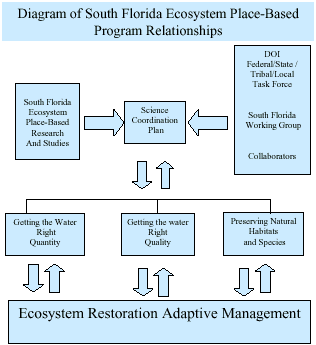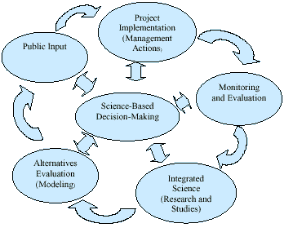U.S. Department of the Interior
U.S. Geological Survey
OFR-00-449
U.S. Geological Survey Program on the South Florida Ecosystem: 2000 ProceedingsPresentations made at the Greater Everglades Ecosystem Restoration (GEER) Conference,
|
| Note: This webpage only contains a partial version of OFR 00-449. You can view and download the entire document below. |

 |
The purpose of this conference is to provide a forum for physical, biological, and social scientists to share their knowledge and research results concerning Everglades restoration. The objectives are to define specific restoration goals, determine the best approaches to meet these goals, and provide benchmarks that can be used to measure the success of restoration efforts over time. The these ends, the conference will recognize the need to synthesize information gathered since the first Everglades conference, the interdisciplinary nature of Everglades restoration, and the need to adapt scientific understanding to management action.
This conference provided a forum for invited presentations by an outstanding array of experts as well as selected oral and poster presentations of research conducted on various aspects of Everglades restoration. Plenary sessions included main themes addressed by invited speakers. Concurrent sessions included presentations grouped by topic. A panel discussion will summarize major findings during the final plenary session.
 |
The U.S. Geological Survey (USGS) conducts scientific investigations in south Florida to improve society’s understanding of the environment and assist in the sustainable use, protection, and restoration of the Everglades and other ecosystems within the region. The investigations summarized in this document have been carried out under the South Florida Ecosystem Program, which is part of the USGS Place-Based Studies Program.
The USGS Placed-Based Studies Program is a nationwide program that concentrates on areas with severe environmental problems. Through interdisciplinary investigations the Program provides sound scientific information on which to base informed resource management decisions. Individuals from all the USGS programs (hydrology, geology, biology, mapping) work together with other scientists to cover the diverse scientific disciplines involved in this complex and challenging task. The South Florida Ecosystem Program began in 1995 as one of the initial Place-Based Studies programs and serves as a model for similar future collaborative studies. Placed-Based Studies are also being conducted in the San Francisco Bay area, Chesapeake Bay, the Platte River, Greater Yellowstone, Salton Sea, and the Mojave Desert.
The South Florida Ecosystem Program is part of a coordinated federal effort, under the South Florida Ecosystem Restoration Task Force. The Task Force was started in 1993, through interagency agreement, to coordinate the efforts of the agencies within six federal departments. In 1996, statutory authority formalized the Task Force and expanded it to include tribal, state, and local governments. The Task Force conducts its activities through the South Florida Ecosystem Working Group and teams, such as the Science Coordination Team. A Science Plan and Integrated Financial Plans are established to focus efforts and prevent duplicative efforts by the agencies.
Organization and Content of the Document
This document presents the results of over 70 studies and 200 investigators that are active in the South Florida Ecosystem Program during the year 2000. The studies are categorized according to the major focuses of the South Florida Ecosystem Restoration Task Force.
Getting the Water Quality Right – reducing or eliminating pollutants and other undesirable substances from the water.
Getting the Water Quantity Right – establishing the volume, quantity, timing and distribution of surface and ground waters to approximate pre- development conditions.
Preserving Natural Habitats and Species – providing the needs of the diverse flora and fauna of this ecologically unique area
Information Availability – exchanging information regarding programs, projects, and activities to promote ecosystem restoration and maintenance - through South Florida Information Access (SOFIA)
This document also includes a bibliography of reports either published or in press, from the South Florida Ecosystem Place-Based Study Program.
South Florida Ecosystem Restoration
Restoring the Everglades is an enormous challenge, that involves returning essential functions to a large (over 11,000 square miles) and diverse ecosystem that has seen significant adverse impacts from man’s activities over the past 50 years. America’s Everglades is a National treasure which must be restored to ensure that south Florida’s unique and irreplaceable natural environment is preserved, assure the quantity and quality of drinking water as well as agricultural and industrial water supplies, and in general improve the quality of life for all south Florida’s inhabitants.
The Comprehensive Everglades Restoration Plan (CERP) was developed over a period of six years by the U.S. Army Corps of Engineers in partnership with the South Florida Water Management District and more than 30 tribes and federal, state and local agencies. It is the primary planning vehicle for achieving the goal of improving the quantity, quality, timing and distribution of water which will return health to this seriously degraded system. CERP proposes costs in excess of $7.8 billion and a time frame of about 30 years to complete this massive and unprecedented restoration effort.
Both the U.S. Government and the State of Florida have made initial funding commitments for Everglades restoration.
The complexity of this undertaking and the severity of the risks involved in an undertaking which includes some 68 interrelated engineering projects mandates a science based approach to its implementation. The USGS, through its South Florida Ecosystem Place Based Program has committed to providing the highest level of scientific expertise to support decision-making and ensure a successful outcome.
USGS Role in South Florida Ecosystem Restoration
In keeping with the mission of the USGS to provide the Nation with reliable, impartial information to describe and understand the Earth, the USGS is involved in water-related, geologic, biologic, land use, and mapping studies that contribute to the safety, health, and well-being of Florida’s citizens. The work conducted encompasses basic data collection, hydrologic investigations, and research. The USGS is capable of conducting multidisciplinary work because of the availability of expertise in geologic, biologic, mapping, and water resources investigations. Expertise is available nationally and can be called upon as needed for complex investigations, training of local personnel, and development of new approaches and technology to address the complex science issues involved in ecosystem restoration.
| Building Scientific Knowledge
Develop new information – Identify the pertinent issues, formulate critical scientific questions related to the issues, and address the questions through appropriate modeling, monitoring and empirical studies. Communicate – Promote improved communication among restoration scientists and managers through scientific conferences, workshops and the mutual exchange of information. Synthesize Scientific Knowledge Relevant to the Issues – Develop techniques for integrating and synthesizing restoration data and distribute the techniques to others involved in restoration efforts. Manage Integrated Data – Archive inventories and other available databases in multigovernmental database management systems that are accessible through the internet and updated regularly. |
Historically, the USGS in Florida has operated basic data collection networks and conducted investigations that provide the foundation for the wise stewardship of water and biological resources of the State. The hydrogeologic framework has been described in many reports, aquifer characteristics have been determined through geophysical logging and pumping tests, and ecological conditions have been monitored. The data that have been collected for the advancement of general knowledge of our natural resources provide the foundation for the understanding of the fate of contaminants in the environment. The data also have been used in the development of hydrologic and ecological models for predicting the effects of additional stresses on the natural resources and provide the tools for evaluation of effects of land use changes and potential contaminant releases in the environment. Real-time data networks, which include the application of satellite or cellular telephone technology to existing data-collection sites across the State, are providing needed information for advanced warning of floods and droughts.
Key Program Results which Contribute to Management Solutions
Several program outputs have directly contributed to management of natural resources in south Florida as follows:
• Detailed topographic information has been incorporated into computer simulation models to analyze alternatives on which the restoration plan has been based.
• Model results from the Across Trophic Level System Simulation (ATLSS) model have been used in resolving issues relating to preservation of the endangered Cape Sable Seaside Sparrow habitat.
• Geophysical studies have been used to determine the groundwater contributions to estuarine areas such as Florida Bay, and have shown that groundwater contribution to the Bay is negligible.
• Isotopic investigations have shown that some of the phosphorus that contributes to the degradation of the Everglades originates from fertilizers, indicating a possible source from the upstream Everglades Agricultural Area.
• Mercury process studies have shown that sulphur plays a major role in mercury methylation, suggesting that reduction in sulphur inputs could be an important strategy in reducing the impacts of methyl mercury on Everglades fauna.
• Improved understanding of mercury processes in the Everglades has assisted in deciding on possible impacts from nutrient removal through stormwater management systems.
• The program has shed light on the effects of nutrient enrichment, effects of altered hydrologic regimes, and suitability of physical properties of rocks and soils for restoration.
• An in-depth understanding of the history of the south Florida ecosystem has helped to shape restoration goals by enhancing appreciation of predevelopment environments and their causes.
• Predictive capability through a suite of hydrological and ecological models has been used to anticipate where water will flow under various scenarios. This will help to establish salinity yardsticks, ensure that urban and agricultural areas have sufficient water and that bird populations and natural ecological dynamics are restored in Florida Bay. The models also serve as tools for the integration of the considerable volume of information collected by numerous restoration-related studies.
• Groundwater-surface water interaction studies in the Everglades have lead to a better understanding of the factors that control these interactions, the current level of interactions and the likely effect of restoration efforts in increasing or decreasing these interactions. This information will help determine the likelihood that pollutants will be cycled through the aquifers and returned by discharge from the aquifer to the surface water system.
Visions and goals are inherently conceptual. Results are concrete. Translating one into the other, especially on the scale required by south Florida ecosystem, is challenging. The restoration project is using models, monitoring, restoration, and performance indicators to translate conceptual ideas to the real world, adapt projects to changing conditions, and provide accountability. Models – Restoration workers employ a series of computerized models to predict the responses of key variable to changing environmental, social, or economic conditions. Developing simulations that forecast responses to different scenarios permits researchers to identify management alternatives as well as target conditions that will yield desired goals. Computerized models also can be updated as new information is gained, allowing predictions to be continually refined. Monitoring – An adaptive management strategy demands continual feedback. Developing and implementing monitoring programs are a major emphasis for many restoration projects. Some monitoring tracks variables subject to rapid change. Other monitoring programs record long term trends. Monitoring data are essential in assessing the effectiveness of restoration actions, tracking progress, and identifying problems or the need for project modification. Performance Indicators – The restoration project also uses quantitative indicators (levels of phosphorus in runoff) and qualitative indicators (quality of life) to track and assess projects. Comparing actual conditions against predicted targets provides a yardstick for measuring the progress (were are we now, how much farther to go?) and for evaluating the results (what are the benefits/are they worth the costs). Models, monitoring, and performance indicators provide direction, feedback, and accountability for both short and long-term actions. This affords flexible, timely, and responsible management of projects and project funds.
KEEPING ON COURSE – MODELS, MONITORING AND PERFORMANCE INDICATORS
Future Directions
Over the past five years from the inception of the USGS Place-Based Program, the focus has mainly been on program planning, data collection, process studies, and development of modeling tools. Several projects have now completed or are nearing completion of this phase and have entered into the phase of data analysis, credibility assurance (quality assurance) initial reporting, final publication of results and evaluations. An important aspect of the work will be analyzing and integrating the information to provide a synthesis of the information to maximize information content and provide management recommendations.
|
|
 |
As implementation of restoration plans proceed, a process of Adaptive Management will be used to ensure that there is flexibility to make adjustments where necessary. It will be necessary to reevaluate assumptions, measure success, and monitor the effects of restoration actions. The USGS Place-Based Program will be well placed to contribute to these efforts due to the wealth of experience gained in the initial phases of restoration. Areas of particular interest will be evaluating the regional impacts of Aquifer Storage and Recovery technology to reduce the risk of long-term detrimental effects and evaluating the effects of changed hydrologic regimes brought about by restoration on the ecology of the area. Additionally, areas such as Lake Okeechobee and the Kissimmee Basin that have not been the main focus of the program so far will be given added attention.
Collaborators:
• Bureau of Indian Affairs
• Florida Department of Environmental Protection
• Florida Geological Survey
• Florida Institute of Oceanography
• Miccosukee Tribe of Indians of Florida
• National Marine Fisheries
• National Marine Sanctuary
• National Park Service
• National Resource Conservation Service
• Office of the Governor
• Seminole Tribe of Florida
• South Florida Water Management District
• U.S. Army Corps of Engineers
• U.S. Environmental Protection Agency
• U.S. Department of Justice
• U.S. Department of Transportation
• U.S. Fish and Wildlife Service
For more information about the GEER Conference:
Note: This is a PDF file and requires Adobe Acrobat Reader to be read. Download Adobe Acrobat Reader ® for free.
This page is: http://sofia.usgs.gov /publications/ofr/00-449/index.html
Comments and suggestions? Contact: Heather Henkel - Webmaster
Last updated: 25 June, 2003 @ 04:51 PM (KP)
